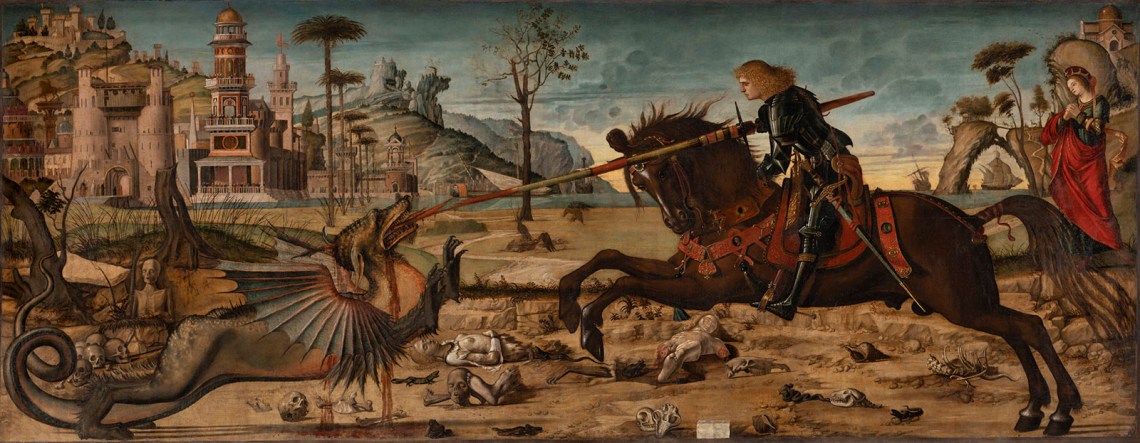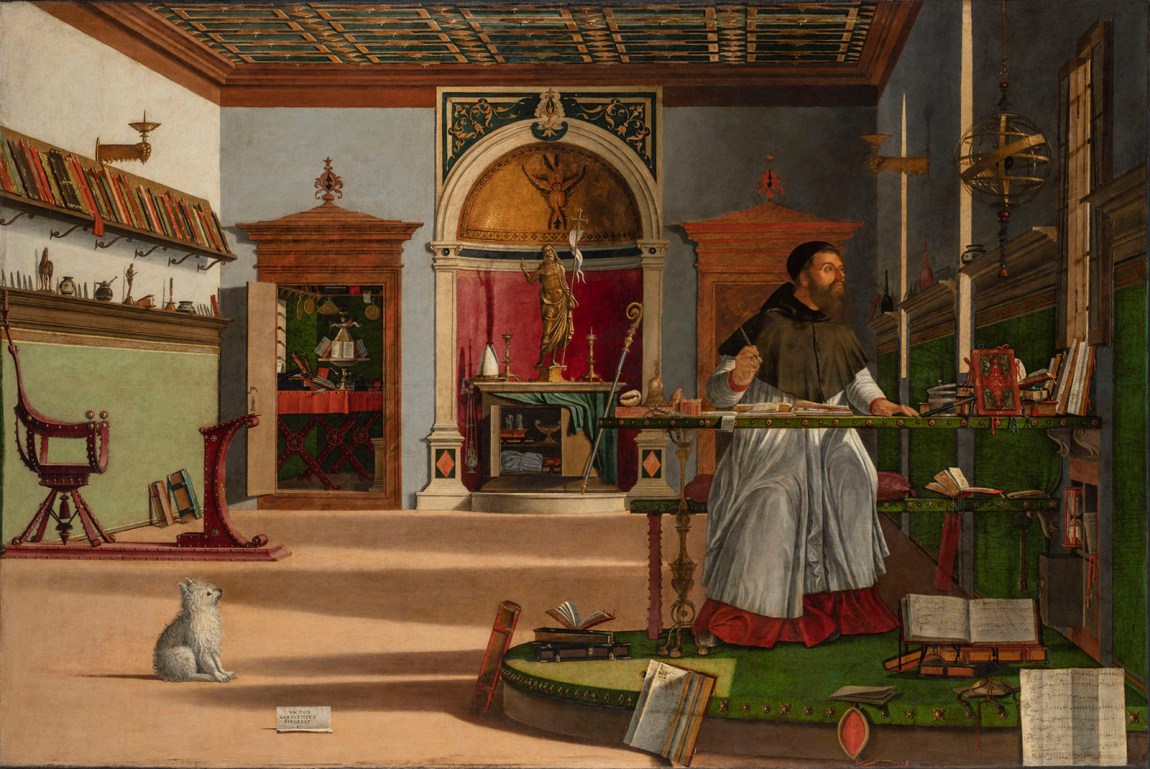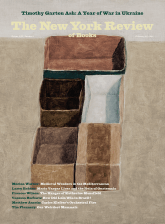That Venice is among the wonders of the world strikes everyone who sees it, but its glory was never greater than in the early sixteenth century, when it was possibly the richest and most cultivated city in Europe. The wealth of its citizens, the splendor of its buildings, the magnificence of the art and tapestries and jewelry on display everywhere, the vitality of its intellectual life, and the stability of its republican form of government made it unlike any other place on earth. One visitor called it “the most triumphant city that I have ever seen.” Erasmus, who lived there for a year, said it was “the most splendid theater of all Italy.”
No artist captured better than Vittore Carpaccio the imaginative grandeur and the ceremonial refinement of Venice in that era. Although overshadowed today by his contemporaries Giovanni Bellini, Giorgione, and Titian, if we want to sense what La Serenissima looked like and felt like around 1500, it is to Carpaccio that we first turn. Exhibitions of his art are comparatively rare, since so many of his most important works are too large or too fragile to leave Venice. The show currently on view at the National Gallery of Art is the first ever outside Italy. Inevitably, it too is shaped by practical limitations on what could be borrowed; still, it is a bracing introduction to this exceptional painter’s career.
Born around 1460–1465, Carpaccio is best known for a series of narrative paintings he created for Venetian religious confraternities—called scuole—in the years around 1500. The most famous of these, dedicated to the martyrdom of Saint Ursula, consists of nine large pictures filled with nearly life-size figures who are shown in vividly imagined and exceptionally varied architectural settings, from the chaste calm of the young saint’s bedroom to the crowded embankments of an English port and the majestic walls of Rome. The pictures are now in the Galleria dell’Accademia in Venice, but in their original site in the assembly hall of the Scuola di Sant’Orsola, they wrapped the walls of the room and provided the viewer with an astonishingly immersive experience. The sense of wonder they create can only fully emerge when you stand in their midst, surrounded by the dreamlike yet believable mix of the marvelous and the commonplace that appears to unfurl around you. Perhaps no other narrative cycle of the Renaissance—not even those of the Sistine Chapel or the Scuola Grande di San Rocco—casts such a strong spell.
Unfortunately the Saint Ursula paintings cannot travel—the biggest of them, Leave-Taking of the Betrothed Pair, is more than twenty feet wide. Likewise, another of Carpaccio’s greatest masterpieces, Miracle of the Possessed Boy at Rialto (1494), could not leave the Accademia. About twelve feet square, this dazzling view of Renaissance Venice is among the most highly wrought and seemingly accurate images of a city to survive from the period; such is the attention to the details of daily life that even the drying laundry, street signs, and chimney pots in the background of the painting are rendered with credible particularity. These pictures are central to Carpaccio’s artistry and fame, and their absence from Washington is keenly felt.
Yet the National Gallery of Art has secured the loan of a number of extraordinary paintings, some of which have never left Venice until now. Moreover, several have been cleaned especially for the exhibition, and to see these works restored and in good light is revelatory. The celebrated picture A Young Knight (1510), from the Museo Nacional Thyssen-Bornemisza in Madrid, has been transformed by conservation, allowing us to experience as never before the rich colors and glossy surfaces Carpaccio loved. Previously dull, the knight’s armor now gleams—you can see his hands and arms reflected in his breastplate—and the flowers in the foreground are so fresh that they seem to sparkle with morning dew. It is perhaps the best preserved of Carpaccio’s paintings, and to view it in its renewed splendor is especially thrilling, since abrasion and overrestoration have marred many of his other pictures, often giving them a dry and dusty appearance.
Also newly cleaned are Saint Augustine in His Study (see illustration below) and Saint George and the Dragon, painted around 1502–1507 for the Scuola degli Schiavoni in Venice. They have always been among the artist’s most admired pictures; now, after the removal of thick layers of brown dirt and yellow varnish, you can finally know what they actually look like. Presented almost side by side at the National Gallery, the two paintings are the heart of the exhibition.
Saint Augustine in His Study shows him looking up from writing at his desk as a flash of heavenly illumination appears, streaming through a window above and lighting up the entire room in a glow of golden radiance. The painting depicts the moment of the death of Saint Jerome, who, now free from mortal limits on human wisdom, has come to Augustine in a vision to instruct him on the ineffable mysteries of the divine; we do not actually see Jerome, just the refulgence of accompanying light that flows into Augustine’s study. The story was recorded in a life of Saint Jerome that was one of the first books printed in Venice, and it was certainly known by the members of the confraternity, who had adopted him as a patron saint at about the time the book was published around 1471.
Advertisement
Aided by this text, we can understand the specificity with which Carpaccio has rendered the scene. He creates the sense of an exact and fleeting instant in time—the light is swelling to a climax and will recede in another moment. Carpaccio applies a similar precision to all the features of the picture, inducing a nearly hypnotic sense of presence, as if you too were standing in the room as the miracle occurs. You know what day it is—September 30, 420, the day of Jerome’s death. You know what time it is—the hour of Compline, about 7 PM. You know where you are—Augustine’s study in the city of Hippo—and you know that you are facing north, since while divine radiance falls from the window in the foreground at the right, early evening sunlight flows from the west into the window of the small room in the background at the left. The sense of actuality is uncanny, as if you are there.
Carpaccio is also exact in his portrayal of the saint’s inner life. As the cleaning of the picture has made clear, Augustine’s eyes glint with the heavenly light pouring into the room, and he is responding by turning toward it: you experience the intensity of his yearning for the divine. Augustine’s Confessions was among the most celebrated books during the Renaissance, and it is easy to imagine that the painter and his patrons intended this depiction to recall famous passages from it: for instance, in book 7, when Augustine describes the light of divine illumination streaming “vehemently” onto his face and flashing like a spark in his eyes, or in book 12 when he writes:
Let me enter into my chamber and sing my love songs to Thee, groaning with inexpressible groaning in my distant wandering, and remembering Jerusalem with my heart stretching upwards in longing.
It is precisely this sort of longing that we see take place before us. Perhaps it is no accident that the books so prominently displayed in the lower right of the picture are open to show one secular and one sacred love song, turned toward us as if inviting us to partake in the music. As a vivid depiction of a saint responding to heavenly light, the painting has few parallels in early Venetian art other than the Frick Collection’s Saint Francis in the Desert, made about thirty years before by Giovanni Bellini, who was likely one of Carpaccio’s teachers.
Saint George and the Dragon also takes place in North Africa, in Silene rather than Hippo. But whereas the picture of Augustine seems to happen immediately before your eyes in the here and now, this one appears to transpire far away and long ago; it is like something out of fairy tale, where nothing is quite real. George is flat in form and stiff in pose, and gives no indication of thought or feeling; his age too is left dreamily vague. The dragon is sheer fantasy—even for an imaginary being, its body, with a long, coiled tail emerging from where its genitalia perhaps should be, makes little sense. The partially eaten corpses strewn about the foreground look more like mannequins than humans ravaged to death. And although the background includes accurate depictions of actual buildings in Cairo and Ancona, the forms of the hills and trees are utterly fanciful. The scene is taken from The Golden Legend, a popular compendium of tales of saints, and not only does the title suggest the quality of fable, but the section in the book about George and the dragon is plainly uncertain and tentative: there are differing accounts, it admits, and no one is sure what really happened.
The contrast between the sense of actuality in Saint Augustine in His Study and fantasy in Saint George and the Dragon is characteristic of Carpaccio. The pictures represent the two poles of his creative imagination. In her brilliant book Venetian Narrative Painting in the Age of Carpaccio (1988), Patricia Fortini Brown dubbed the first tendency “the eyewitness style,” which, she suggested, was intended to make depictions of the miraculous seem more credible by showing them as occurring in everyday settings. In its apparent honesty, an image of this kind was meant to have a heightened sense of authenticity, and it was rooted in a long-standing Venetian tradition of treating official images at St. Mark’s Basilica and the Doge’s Palace as authoritative testimony of historical events.
Advertisement
Carpaccio’s taste for make-believe also can be viewed in relation to common traits in Venetian culture. It was a city of merchants and adventurers who roamed all over the world and returned with exotic tales from distant lands. The most famous example, of course, is Marco Polo in the late thirteenth century, but travelers in Carpaccio’s day, such as Giosafat Barbaro, who published a book about his wanderings in Persia, kept this fashion alive.
Venetians around 1500 also still had a nearly bottomless appetite for medieval romances and chivalric tales of daring knights and damsels, despite the burgeoning interest in classical literature. And they loved dress-up and feasts and theater to an extraordinary degree. To read the diaries of the historian Marino Sanudo, who very likely knew Carpaccio, is to enter a dizzying whirl where the city’s elites constantly put on plays, jousts, costume parties, and mummery parades. For example, in 1505, around the time the artist painted Saint George and the Dragon, one festival included a performance in the Piazza San Marco of what Sanudo describes as “a splendid fable” with a castle and a serpent of fire. The Venetian love of spectacle, it has been suggested, may even help explain why so many of Carpaccio’s pictures appear to depict actors standing on a stage in front of a theatrical backdrop.
Both modes—actuality and fantasy—have elicited from modern viewers the feeling that Carpaccio is ingenuous, unaffected, and sincere, for it seems that he is either telling the truth without embellishment or reciting a tale from the nursery. His is apparently an artless art, and he must be trustworthy and childlike. John Ruskin, who did so much to revive interest in the painter, said his pictures were full of the “extreme joy of childhood.” Henry James called him “the most personal and sociable of artists.” Jan Morris spoke of him as a friend whose art was above all characterized by kindness. They—we—are all beguiled and enchanted.
What this response tends to overlook is the immense skill and intense labor required to create the illusion of transparency. Yet Carpaccio wants us to be aware; he wants our praise for his inventiveness and facility. Hence so many of his paintings depict in the foreground a cartellino—a small piece of white paper—that bears not only his signature but some words calling attention to his artistry. The one in Saint Augustine in His Study, for example, states in Latin, “Vittore Carpaccio imagined this,” as if to say, “The picture may look real, but only because it is my creation.”
Also on view at the National Gallery of Art are thirty preparatory drawings, which help us understand how Carpaccio created such affecting illusions. As we can see in his sketch for the Dream of Saint Ursula, one starting point was to imagine the picture as a container of space and light. The airy gentleness that so many of his best works convey is a quality he sought from the very beginning. Another was to set down the fundamental rhythm of the placement of the principal figures. In his pen drawings The Prince Taking Leave of His Father (1495) and Processing Figures (circa 1497), the protagonists move with the stately grace of dancers in a pavane. Only once he had set the cadence of the central group did Carpaccio move on and sketch out the additional elements. His drawing Fortified Harbor with Shipping (1495), which he based on a print of the port of Ancona and which served as the basis for part of the landscape in a picture in the Saint Ursula cycle, is one such component. The compositional studies made at an advanced stage in planning for the Funeral of Saint Jerome (1502) and Saint Augustine in His Study show how he assembled the disparate parts into a satisfying and decorous whole. The exhibition also has a number of sketches of individual figures, such as Kneeling Clerics (circa 1507–1508), but these have a rough and scratchy feel; they are far less fluid than comparable drawings of the period made in Florence and Rome.
The National Gallery of Art has brought together for the first time in sixty years all the paintings from the narrative cycle Carpaccio made for the Scuola degli Albanesi—the assembly house of the immigrant community from Albania living in early-sixteenth-century Venice. They were relatively poor among Carpaccio’s patrons and evidently could not afford his best efforts; unmistakably, the pictures were painted with extensive help from the artist’s workshop. Yet while lacking the sparkle and flourish of his greatest images, the six canvases in the series recounting the life of the Virgin still radiate an air of profound serenity, thanks to the rhythmic composition of the figures and the clear order of the spaces and architecture. To see them all in a line helps us to comprehend how he was able to unite the multiple scenes of a cycle in one moving ensemble.
For the last ten years of his career before his death around 1526, Carpaccio’s creative energy waned significantly, and he relied ever more on assistants, including his two sons, to help make his pictures. In this period, his work was no longer fashionable in Venice; younger painters such as Titian now held sway. To find a market, Carpaccio was frequently forced to ship his works to cities abroad, particularly on the eastern shore of the Adriatic. Many of his pictures from this time are formulaic and dull. While the last two rooms of the show feature several extraordinary works, especially the enormous Lion of Saint Mark (1516) and the gigantic altarpiece Martyrdom of the Ten Thousand Christians on Mount Ararat (1515), it is the weaker works of this period that dominate these galleries, and it makes for a dispiriting conclusion to what is otherwise a beautiful exhibition.
The catalog shares this unevenness. Conceived primarily as a record of the show, it underemphasizes the major cycles that could not travel and places more focus than would otherwise be necessary on the paintings of the late years. Nonetheless, there are some excellent contributions, and it is beautifully printed, which is especially welcome since many volumes on the artist have illustrations that are so muddy and poor as to be of little use.
To supplement the catalog there are other books that an interested reader might want to consult. Published thirty-five years ago, Brown’s Venetian Narrative Painting in the Age of Carpaccio remains the most imaginative and penetrating analysis of his work. Carpaccio in Venice (2021), a guidebook edited by Brown and Gabriele Matino, provides an excellent introduction to the artist. And there is Ciao, Carpaccio! (2014), one of the last books Jan Morris wrote in her distinguished career. Composed when she was almost ninety, it is a love letter to Venice and Carpaccio, and it is tinged with a kind of retrospective nostalgia and gratitude for the beauty of life.
It is fitting that Carpaccio should inspire a response of this sort, since his work at its best radiates a sense of plenitude and festivity, grace and dignity. The exhibition will move from Washington to Venice, where it will open in mid-March. There the art Ruskin called a “magic mirror” will reflect even more directly its source in the streets and canals and splendors of the “most triumphant city” of Renaissance Italy.





